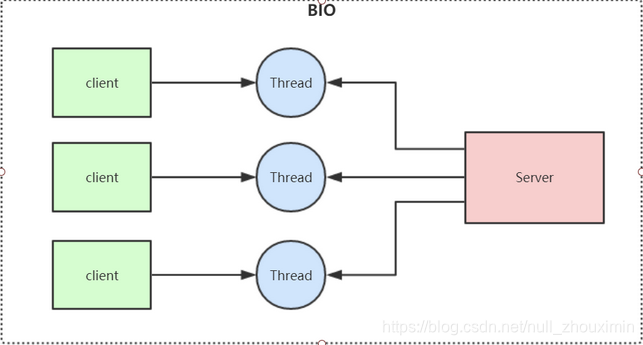深入理解NIO与Epoll
IO模型
IO模型就是说用什么样的通道进行数据的发送和接收,Java一共支持3种网络编程IO模式:BIO和NIO,AIO。
BIO (Blocking IO)
这个是同步阻塞的模型,一个客户端只能链接对应处理一个线程。
代码示例:
package com.atzxm.bio;
/**
* @author zhouximin
* @create 2021-01-17-下午7:13
*/
import java.io.IOException;
import java.net.ServerSocket;
import java.net.Socket;
public class SocketServer {
public static void main(String[] args) throws IOException {
ServerSocket serverSocket = new ServerSocket(9000);
while (true) {
System.out.println("等待连接。。");
//阻塞方法
Socket clientSocket = serverSocket.accept();
System.out.println("有客户端连接了。。");
handler(clientSocket);
/*new Thread(new Runnable() {
@Override
public void run() {
try {
handler(clientSocket);
} catch (IOException e) {
e.printStackTrace();
}
}
}).start();*/
}
}
private static void handler(Socket clientSocket) throws IOException {
byte[] bytes = new byte[1024];
System.out.println("准备read。。");
//接收客户端的数据,阻塞方法,没有数据可读时就阻塞
int read = clientSocket.getInputStream().read(bytes);
System.out.println("read完毕。。");
if (read != -1) {
System.out.println("接收到客户端的数据:" + new String(bytes, 0, read));
}
clientSocket.getOutputStream().write("HelloClient".getBytes());
clientSocket.getOutputStream().flush();
}
}
- 缺点:
- IO代码里read操作是阻塞操作,如果连接不做数据读写操作会导致线程阻塞,浪费资源
- 如果线程很多,会导致服务器线程太多,压力太大,比如C10K问题
- 应用场景
- BIO 方式适用于连接数目比较小且固定的架构, 这种方式对服务器资源要求比较高, 但程序简单易理解。
NIO(Non Blocking IO)
同步非阻塞,服务器实现模式为一个线程可以处理多个请求(连接),客户端发送的连接请求都会注册到多路复用器selector上,多路复用器轮询到连接有IO请求就进行处理,JDK1.4开始引入。
应用场景:
NIO方式适用于连接数目多且连接比较短(轻操作) 的架构, 比如聊天服务器, 弹幕系统, 服务器间通讯,编程比较复杂
NIO非阻塞代码示例:
package com.atzxm.nio;
import java.io.IOException;
import java.net.InetSocketAddress;
import java.nio.ByteBuffer;
import java.nio.channels.ServerSocketChannel;
import java.nio.channels.SocketChannel;
import java.util.ArrayList;
import java.util.Iterator;
import java.util.List;
public class NioServer {
// 保存客户端连接
static List<SocketChannel> channelList = new ArrayList<>();
public static void main(String[] args) throws IOException, InterruptedException {
// 创建NIO ServerSocketChannel,与BIO的serverSocket类似
ServerSocketChannel serverSocket = ServerSocketChannel.open();
serverSocket.socket().bind(new InetSocketAddress(9000));
// 设置ServerSocketChannel为非阻塞
serverSocket.configureBlocking(false);
System.out.println("服务启动成功");
while (true) {
// 非阻塞模式accept方法不会阻塞,否则会阻塞
// NIO的非阻塞是由操作系统内部实现的,底层调用了linux内核的accept函数
SocketChannel socketChannel = serverSocket.accept();
if (socketChannel != null) {
// 如果有客户端进行连接
System.out.println("连接成功");
// 设置SocketChannel为非阻塞
socketChannel.configureBlocking(false);
// 保存客户端连接在List中
channelList.add(socketChannel);
}
// 遍历连接进行数据读取
Iterator<SocketChannel> iterator = channelList.iterator();
while (iterator.hasNext()) {
SocketChannel sc = iterator.next();
ByteBuffer byteBuffer = ByteBuffer.allocate(128);
// 非阻塞模式read方法不会阻塞,否则会阻塞
int len = sc.read(byteBuffer);
// 如果有数据,把数据打印出来
if (len > 0) {
System.out.println("接收到消息:" + new String(byteBuffer.array()));
} else if (len == -1) {
// 如果客户端断开,把socket从集合中去掉
iterator.remove();
System.out.println("客户端断开连接");
}
}
}
}
}
- 通过一个 channelList 保存所有的 经过serverSocket.accept()拿到的Channel。然后会去遍历所有的channelList去尝试读取数据。但是有一些只是创建了连接,并没有发送数据所有会有很多无效Channel。
- 总结:如果连接数太多的话,会有大量的无效遍历,假如有10000个连接,其中只有1000个连接有写数据,但是由于其他9000个连接并没有断开,我们还是要每次轮询遍历一万次,其中有十分之九的遍历都是无效的,这显然不是一个让人很满意的状态。
NIO引入多路复用器代码示例:
package com.atzxm.nio;
import java.io.IOException;
import java.net.InetSocketAddress;
import java.nio.ByteBuffer;
import java.nio.channels.SelectionKey;
import java.nio.channels.Selector;
import java.nio.channels.ServerSocketChannel;
import java.nio.channels.SocketChannel;
import java.util.Iterator;
import java.util.Set;
public class NioSelectorServer {
public static void main(String[] args) throws IOException, InterruptedException {
// 创建NIO ServerSocketChannel
ServerSocketChannel serverSocket = ServerSocketChannel.open();
//ServerSocketChannel serverSocket2 = ServerSocketChannel.open();
//绑定端口
serverSocket.socket().bind(new InetSocketAddress(9000));
//serverSocket2.socket().bind(new InetSocketAddress(9001));
// 设置ServerSocketChannel为非阻塞
serverSocket.configureBlocking(false);
//serverSocket2.configureBlocking(false);
// 打开Selector处理Channel,即创建epoll
Selector selector = Selector.open();
// 把ServerSocketChannel注册到selector上,并且selector对客户端accept连接操作感兴趣并且会生成
//一个SelectionKey
SelectionKey register = serverSocket.register(selector, SelectionKey.OP_ACCEPT);
//serverSocket2.register(selector, SelectionKey.OP_ACCEPT);
System.out.println("服务启动成功");
while (true) {
// 阻塞等待需要处理的事件发生
selector.select();
// 获取selector中注册的全部事件发生的 SelectionKey 实例
Set<SelectionKey> selectionKeys = selector.selectedKeys();
Iterator<SelectionKey> iterator = selectionKeys.iterator();
// 遍历SelectionKey对事件进行处理
while (iterator.hasNext()) {
SelectionKey key = iterator.next();
// 如果是OP_ACCEPT事件,则进行连接获取和事件注册
if (key.isAcceptable()) {
ServerSocketChannel server = (ServerSocketChannel) key.channel();
//生成一个SocketChannel 并且将其注册到selector中。
SocketChannel socketChannel = server.accept();
socketChannel.configureBlocking(false);
// 这里只注册了读事件,如果需要给客户端发送数据可以注册写事件
socketChannel.register(selector, SelectionKey.OP_READ);
System.out.println("客户端连接成功");
} else if (key.isReadable()) {
// 如果是OP_READ事件,则进行读取和打印
SocketChannel socketChannel = (SocketChannel) key.channel();
ByteBuffer byteBuffer = ByteBuffer.allocate(128);
int len = socketChannel.read(byteBuffer);
// 如果有数据,把数据打印出来
if (len > 0) {
System.out.println("接收到消息:" + new String(byteBuffer.array()));
} else if (len == -1) {
// 如果客户端断开连接,关闭Socket
System.out.println("客户端断开连接");
socketChannel.close();
}
}
//从事件集合里删除本次处理的key,防止下次select重复处理
iterator.remove();
}
}
}
}

- 为了解决普通Nio的弊端这里引入了多路复用器(Selector)
添加了多路复用器之后,每一次只会去响应事件发生的socketChannel。注意:因为我们只注册了一个accept Selector,所以每一次select 我们只能响应一个accept selector。 - 如何去检测注册的socketChannel是否响应事件?
jdk1.4之前使用的是linux函数 select 和poll 是去遍历所有的sockchannel 看是否在响应事件。
1.4之后,使用epoll模型。
几个关键函数源码分析
- Selector.open() //创建多路复用器
追踪源码到- int epfd = epoll_create(256)
会调用linux的epoll_create()函数,会返回一个文件描述符。可以通过epfd找到对应的epoll文件。
- int epfd = epoll_create(256)
- socketChannel.register(selector, SelectionKey.OP_READ)
追踪源码到- pollWrapper.add(fd)
fd 就是注册socketChannel对应的文件放到pollWrapper里面一个集合,就是和seletor暂时关联
- pollWrapper.add(fd)
- selector.select() //阻塞等待需要处理的事件发生
追踪源码到- pollWrapper.poll(timeout);
- updateRegistrations();
- epollCtl()
会调用linux的epoll_ctl():
使用文件描述符epfd引用的epoll实例,对目标文件描述符fd执行op操作。int epoll_ctl(int epfd, int op, int fd, struct epoll_event *event);
参数epfd表示epoll对应的文件描述符,参数fd表示socket对应的文件描述符。
参数op有以下几个值:
EPOLL_CTL_ADD:注册新的fd到epfd中,并关联事件event;
EPOLL_CTL_MOD:修改已经注册的fd的监听事件;
EPOLL_CTL_DEL:从epfd中移除fd,并且忽略掉绑定的event,这时event可以为null;
参数event是一个结构体 - epollCtl()
struct epoll_event {
__uint32_t events; /* Epoll events */
epoll_data_t data; /* User data variable */
};
typedef union epoll_data {
void *ptr;
int fd;
__uint32_t u32;
__uint64_t u64;
} epoll_data_t;
events有很多可选值,这里只举例最常见的几个:
EPOLLIN :表示对应的文件描述符是可读的;
EPOLLOUT:表示对应的文件描述符是可写的;
EPOLLERR:表示对应的文件描述符发生了错误;
成功则返回0,失败返回-1
int epoll_wait(int epfd, struct epoll_event *events, int maxevents, int timeout);
等待文件描述符epfd上的事件。在epoll上有一个rdlist里面有没有事件响应,如果有会将其放到selector的keys里面,如果没有回阻塞。
epfd是Epoll对应的文件描述符,events表示调用者所有可用事件的集合,maxevents表示最多等到多少个事件就返回,timeout是超时时间。
I/O多路复用底层主要用的Linux 内核函数(select,poll,epoll)来实现,windows不支持epoll实现,windows底层是基于winsock2的select函数实现的(不开源)